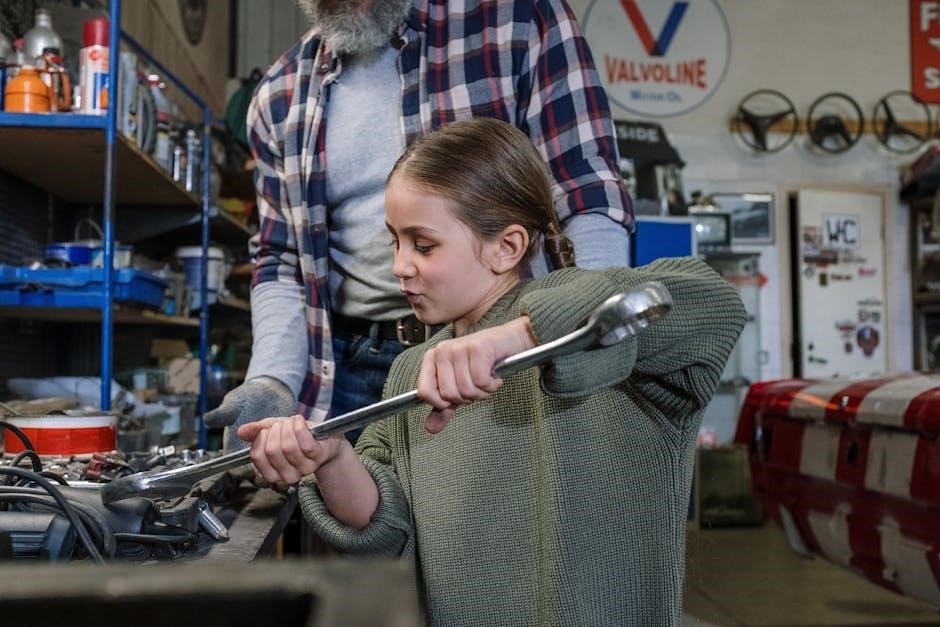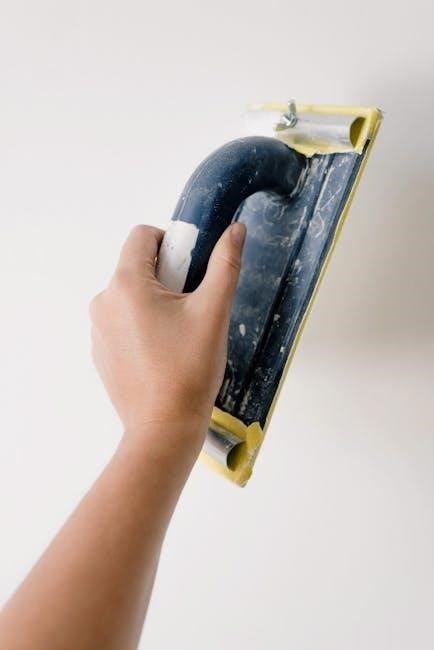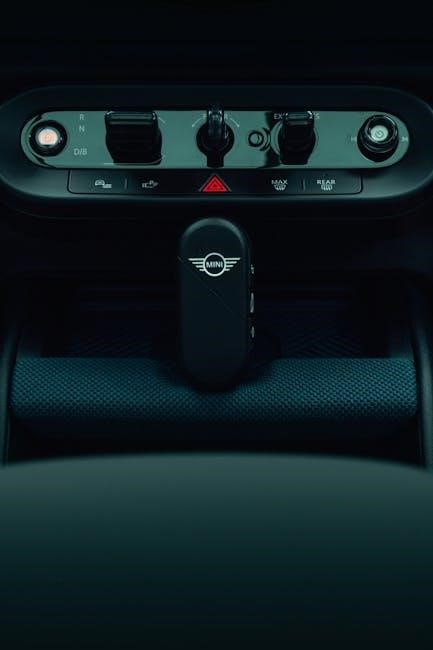A Mini Cooper repair manual is a comprehensive guide for owners and mechanics, detailing procedures for maintenance, diagnostics, and repairs. It empowers car owners to perform DIY tasks confidently, ensuring optimal vehicle performance and longevity. With a history dating back to 1959, Mini Cooper models have evolved significantly, making these manuals essential for understanding both classic and modern variants. They are indispensable resources for anyone aiming to keep their Mini Cooper in pristine condition.
1.1 What is a Repair Manual?
A repair manual is a detailed guide providing step-by-step instructions for diagnosing, maintaining, and repairing a vehicle. It is designed for both professional mechanics and DIY enthusiasts, offering comprehensive information on various car systems. For Mini Cooper owners, a repair manual typically includes troubleshooting guides, wiring diagrams, and replacement procedures. It covers essential tasks like oil changes, brake pad replacements, and timing chain adjustments, ensuring owners can address issues effectively. Additionally, it often includes specifications, torque values, and safety precautions to guarantee proper repairs. Available in print or digital formats, including free PDF downloads, repair manuals are invaluable resources for anyone looking to maintain or restore their Mini Cooper. They empower car owners to save money and gain a deeper understanding of their vehicle’s mechanics.
1.2 Importance for Car Owners
A repair manual is an essential resource for Mini Cooper owners, offering detailed insights into vehicle maintenance and repair. It empowers car owners to perform DIY tasks, reducing reliance on professional mechanics and saving money. By understanding repair procedures, owners can identify potential issues early, preventing costly breakdowns. The manual also serves as a reference for routine maintenance, ensuring the car runs optimally and maintains its value. For enthusiasts, it provides a deeper understanding of the vehicle’s mechanics, fostering a sense of control and confidence. Access to a free PDF manual makes this knowledge even more accessible, allowing owners to troubleshoot and repair their Mini Cooper efficiently. This resource is invaluable for anyone aiming to extend their car’s lifespan and maintain its performance.
1.3 Brief History of Mini Cooper Models
The Mini Cooper, first introduced in 1959 by the British Motor Corporation, revolutionized compact car design with its fuel efficiency and iconic style. The Classic Mini (1959–2000) became a cultural symbol, while the second generation (2000–2006), under BMW, modernized the brand with advanced features. The third generation (2013–present) expanded the lineup, including models like the Cooper S, Convertible, and Clubman. Each generation maintained the Mini’s signature charm while embracing innovation. Understanding this history helps owners relate to their vehicle’s design and repair needs. Access to free PDF repair manuals ensures owners of all Mini Cooper models can maintain and repair their cars effectively, preserving their legacy and performance.

Where to Find Free PDF Manuals
Free Mini Cooper repair manuals can be found on official Mini websites, third-party automotive platforms, and online communities. Websites like Internet Archive and Scribd often host downloadable PDF versions.

2.1 Official Mini Cooper Websites
Official Mini Cooper websites are a reliable source for free PDF repair manuals. These manuals are designed to provide detailed instructions for maintenance, troubleshooting, and repairs. They are tailored to specific Mini Cooper models, ensuring accuracy and relevance. By visiting the official Mini Cooper website, users can access interactive tools, instructional videos, and downloadable PDF manuals. These resources are regularly updated to reflect the latest technical specifications and model changes. The official website often includes a search function, allowing users to find manuals for their specific vehicle year and model. Additionally, some official sources may offer sections dedicated to DIY repairs and maintenance schedules, making it easier for owners to keep their vehicles in optimal condition. These manuals are free and accessible, providing a trustworthy resource for Mini Cooper enthusiasts and mechanics alike.
2.2 Third-Party Automotive Websites
Third-party automotive websites are a valuable resource for finding free PDF repair manuals for Mini Cooper models. Websites like Internet Archive and Scribd often host comprehensive service manuals, including those for Mini Cooper models from 2002 to 2013. These manuals are uploaded by enthusiasts or independent publishers and are accessible for free. Additionally, forums and communities dedicated to Mini Cooper owners frequently share links to downloadable manuals. Some third-party sites specialize in automotive repair manuals, offering detailed guides for specific models. For example, the Haynes repair manual for Mini Cooper is widely available on such platforms. While these sources are convenient, users should verify the manual’s compatibility with their vehicle’s make and year to ensure accuracy. These third-party websites provide a cost-effective solution for DIY enthusiasts seeking detailed repair information.
2.3 Online Communities and Forums
Online communities and forums are excellent platforms for locating free Mini Cooper repair manuals in PDF format. Websites like Reddit, specialized Mini Cooper forums, and automotive enthusiast groups often share links to downloadable manuals. These communities are populated by experienced owners and mechanics who understand the importance of accessible repair information. Users can request specific manuals for their model year or engine type, and members often provide direct links or upload the files to shared repositories. Additionally, these forums offer a space to ask questions and receive guidance from knowledgeable individuals. While some forums may require registration, the wealth of information available makes them a valuable resource for DIY enthusiasts. By engaging with these communities, Mini Cooper owners can access the repair manuals they need to maintain or repair their vehicles effectively. These platforms foster collaboration and knowledge sharing, benefiting both new and experienced car owners.

Key Sections of the Repair Manual
A repair manual typically includes diagnostic procedures, maintenance schedules, and detailed repair guides. These sections provide step-by-step instructions for common issues, helping owners address problems effectively and safely.
3.1 Diagnostic Procedures
Diagnostic procedures in a Mini Cooper repair manual guide users through identifying and troubleshooting common issues. These sections often include step-by-step instructions for testing electrical systems, checking error codes, and inspecting mechanical components. Detailed diagrams and charts help pinpoint potential faults, such as engine misfires or transmission malfunctions; Many manuals also emphasize the use of specialized tools, like OBD-II scanners, to diagnose modern computer-controlled systems. By following these procedures, owners can efficiently determine the root cause of problems, ensuring timely and effective repairs. This section is crucial for both novice DIYers and experienced mechanics, as it provides a clear roadmap for resolving issues without guesswork.
3.2 Maintenance Schedule
A maintenance schedule in a Mini Cooper repair manual outlines the regular services and inspections necessary to keep the vehicle in optimal condition. It typically includes tasks such as oil changes, tire rotations, brake inspections, and fluid replacements, with specific intervals recommended by the manufacturer. Following this schedule ensures that potential issues are identified early, preventing costly repairs and extending the car’s lifespan. The manual often categorizes maintenance by mileage or time intervals, providing clear guidelines for both minor and major services. Adhering to this schedule is crucial for maintaining performance, fuel efficiency, and reliability. Users can also find recommendations for seasonal checks and preparatory work for long trips, making it an essential resource for proactive car care.
3.3 Common Repair Procedures
The Mini Cooper repair manual details common repair procedures, such as timing chain replacements, coolant system maintenance, and clutch repairs. These procedures are frequently encountered due to the vehicle’s design and mileage accumulation. Timing chain issues, for instance, are prevalent in certain Mini Cooper models, requiring precise replacement steps to avoid engine damage. The manual provides step-by-step instructions, including tool recommendations and torque specifications, ensuring repairs are done correctly. Additionally, it covers coolant system flushes, essential for preventing overheating, and clutch replacements, which are common in manual transmission models. By following these procedures, owners can address issues effectively, maintaining their car’s performance and reliability. The manual’s clear guidance makes these repairs accessible for both novice and experienced DIY enthusiasts, emphasizing safety and precision throughout the process.

Tools and Equipment Needed
Essential tools like screwdrivers, wrenches, and pliers are required for Mini Cooper repairs. Specialized tools, such as an OBD-II scanner, may also be necessary for advanced diagnostics and adjustments.
4.1 Essential Tools for DIY Repairs
Essential tools for Mini Cooper DIY repairs include screwdrivers, wrenches, pliers, and socket sets. A torque wrench is crucial for precise bolt tightening. Additional tools like a multimeter for electrical diagnostics and a jack with jack stands for safe lifting are recommended. While basic tools suffice for minor repairs, specialized tools may be needed for complex tasks. Always refer to the repair manual for specific tool requirements to ensure proper repairs and avoid damage. Using the correct tools is vital for safety and effectiveness.
4.2 Specialized Tools for Mini Cooper
Specialized tools for Mini Cooper repairs are essential for addressing model-specific components. A MINI DIS diagnostic tool is required for advanced troubleshooting and coding. A camshaft locking tool is necessary for timing chain replacements. Additionally, a steering lock puller and suspension compression tool are often needed for precise adjustments. These tools are designed to fit the unique engineering of Mini Cooper models. While basic tools suffice for minor tasks, specialized tools ensure accuracy and prevent damage during complex repairs. They are typically recommended in repair manuals for procedures like clutch replacements or engine overhauls. Investing in these tools is crucial for DIY enthusiasts aiming to maintain their Mini Cooper effectively and safely.
4.3 Safety Equipment Recommendations
Safety equipment is crucial when performing repairs on your Mini Cooper. Essential items include high-quality gloves, safety glasses, and a fire extinguisher. A well-ventilated workspace is vital to avoid inhaling harmful fumes. Use a high-quality jack and jack stands designed for the Mini Cooper’s weight to ensure stability while working underneath the vehicle. Always wear protective eyewear and keep loose clothing or jewelry secure to prevent accidents. Proper lighting is essential for visibility during repairs. Refer to the repair manual for specific safety precautions related to your model. Adhere to these guidelines to minimize risks and ensure a safe working environment. Regularly inspect your tools and equipment for damage or wear. By prioritizing safety, you can confidently perform repairs while protecting yourself and your vehicle.

Troubleshooting Common Issues
Identify and address common problems like engine misfires, transmission slipping, or electrical faults. Use diagnostic tools and the repair manual to pinpoint issues and apply effective solutions promptly.
5.1 Engine Problems
Mini Cooper engines can experience issues like misfires, rough idling, or decreased performance. Common causes include faulty spark plugs, oxygen sensor malfunctions, or vacuum leaks. Drivers may notice symptoms such as reduced power, stalling, or illuminated check engine lights. Diagnostic trouble codes like P0300 (random cylinder misfire) or P0171 (system too lean) often indicate these problems. Regular maintenance, such as spark plug replacement and sensor checks, can prevent engine issues. Consulting the repair manual provides step-by-step guidance for diagnosing and repairing these faults. It also outlines tools and procedures for more complex tasks, ensuring owners can address problems effectively. Proper troubleshooting helps maintain engine health and prevents costly repairs. By following the manual’s instructions, drivers can restore their Mini Cooper’s performance and reliability.
5.2 Transmission Issues
Mini Cooper transmission issues often manifest as erratic gear shifts, slipping, or unusual noises. Common problems include faulty solenoids, low transmission fluid levels, or worn clutch packs. Symptoms like hesitation between gears or failure to engage gear can indicate these faults. Diagnostic trouble codes such as P0700 (transmission control system malfunction) or P0730 (incorrect gear ratio) may appear. Regular fluid checks and filter replacements, as outlined in repair manuals, can help prevent these issues. Addressing transmission problems promptly is crucial to avoid major repairs. The repair manual provides detailed procedures for diagnosing and repairing transmission-related faults, ensuring smooth operation and longevity of the vehicle. By following the manual’s guidance, owners can resolve transmission issues effectively and maintain their Mini Cooper’s performance.
5.3 Electrical System Faults
Electrical system faults in Mini Coopers can cause a range of issues, from warning lights on the dashboard to complete system failures. Common problems include faulty sensors, blown fuses, or malfunctioning control modules. Symptoms may include the car not starting, inconsistent power steering, or erratic infotainment system behavior. Diagnostic trouble codes, such as those related to the CAN bus or battery voltage, can help pinpoint the issue. Repair manuals provide step-by-step guidance for troubleshooting, such as checking wiring harnesses, testing fuses, or replacing faulty components. Regular maintenance, like cleaning battery terminals and ensuring proper connections, can prevent many electrical issues. Addressing these faults promptly is crucial to avoid further damage and ensure reliable vehicle operation. The repair manual is an essential resource for identifying and resolving electrical system faults effectively.

DIY Repair Guides
DIY repair guides for Mini Cooper provide step-by-step instructions for common tasks like oil changes and brake pad replacements. They empower owners to save money and gain mechanical insight.
6.1 Oil Change and Filter Replacement
Oil changes and filter replacements are essential for maintaining your Mini Cooper’s engine health. The repair manual provides detailed steps to ensure proper execution. Start by gathering materials like oil drain pans, new filters, and the correct oil grade. Locate the oil drain plug, typically under the car, and safely drain the old oil. Replace the filter with a new one, ensuring no residue remains. Refill the engine with the recommended oil volume. Dispose of used oil and filters responsibly. Regular oil changes prevent engine wear and maintain fuel efficiency. Always refer to your specific Mini Cooper model’s manual for precise instructions and guidelines.
6.2 Brake Pad Replacement
Brake pad replacement is a critical maintenance task for your Mini Cooper, ensuring safety and optimal braking performance. Start by gathering tools like a jack, lug wrench, and screwdrivers. Raise the vehicle and remove the wheels to access the brake assembly. Remove the caliper bolts and slide off the caliper, taking care not to damage the brake hose. Extract the old brake pads and inspect the rotor for damage. Install the new pads, ensuring they are properly seated. Reattach the caliper and tighten all bolts securely. Reassemble the wheels and lower the vehicle. Test the brakes thoroughly to ensure proper function. Regular pad replacement, as outlined in your repair manual, prevents excessive wear on other brake components and maintains reliable stopping power.

6.3 Timing Chain Replacement
Replacing the timing chain in your Mini Cooper is a complex procedure that requires precision to ensure engine longevity. Start by disconnecting the battery and gaining access to the engine compartment. Remove the serpentine belt, water pump, and other components to expose the timing chain cover. Use a socket to loosen the harmonic balancer and remove it. Mark the chain and gears for alignment, then remove the tensioners and slide off the chain. Inspect the tensioner rails and guides for wear. Install the new timing chain, ensuring proper alignment with the marks. Reinstall the tensioners and tighten all bolts to the specified torque. Reassemble the components in the reverse order of removal. Finally, reconnect the battery and test the engine for proper operation. Always refer to your repair manual for exact specifications and precautions to avoid engine damage.

Advanced Repair Techniques
Advanced techniques involve complex procedures like clutch replacement and engine overhauls, requiring specialized tools and expertise. These repairs demand precision and adherence to manual specifications for optimal results.
7.1 Replacing the Clutch
Replacing the clutch in a Mini Cooper is a challenging task that requires mechanical expertise. It involves removing the transmission, inspecting the flywheel, and installing a new clutch kit. Proper alignment and lubrication are crucial to ensure smooth operation. Specialized tools like a clutch alignment tool and a jack stand are essential. The repair manual provides step-by-step instructions, torque specifications, and safety precautions. It is recommended to follow the manufacturer’s guidelines to avoid costly errors. Additionally, online forums and repair communities offer valuable insights and troubleshooting tips for common issues during the clutch replacement process. Always refer to the official Mini Cooper repair manual for accurate and detailed guidance.
7.2 Overhauling the Engine
Overhauling the engine in a Mini Cooper is a complex process that requires meticulous attention to detail and advanced mechanical skills. It involves dismantling the engine, inspecting and replacing worn or damaged components, and reassembling it with precision. The repair manual provides detailed step-by-step instructions, including torque specifications, alignment procedures, and recommended tools. Specialized tools, such as piston ring compressors and bearing pullers, are essential for the task. The manual also outlines how to handle critical components like the cylinder head, crankshaft, and camshaft. Proper cleaning and lubrication of parts are emphasized to ensure optimal performance. For DIY enthusiasts, the manual serves as a comprehensive guide, while experienced mechanics may find it a valuable reference for troubleshooting and precision work. Always refer to the official Mini Cooper repair manual for accurate and detailed guidance.
7.3 Upgrading Suspension Systems
Upgrading the suspension system in a Mini Cooper can significantly enhance handling, stability, and overall driving performance. The repair manual provides detailed guidelines for replacing or modifying suspension components, such as coilovers, shocks, and anti-roll bars. It outlines the tools and techniques required for a successful upgrade, including alignment adjustments and torque specifications. DIY enthusiasts should ensure they have access to specialized tools like spring compressors and suspension alignment kits. The manual also covers how to integrate aftermarket parts while maintaining compatibility with the vehicle’s original geometry. Proper installation and testing are critical to avoid compromising safety or performance. Always refer to the official Mini Cooper repair manual for precise instructions and specifications to achieve the desired upgrade outcomes effectively.

Legal and Safety Considerations
Always wear safety gear and ensure proper tools are used. Adhere to legal regulations and environmental guidelines during repairs. Consult professionals for complex tasks to avoid liability.
8.1 Warranty Implications of DIY Repairs
Performing DIY repairs may void your Mini Cooper’s warranty if not done according to manufacturer specifications. Always review your vehicle’s warranty terms to understand what is covered and what may invalidate it. Improper repairs can lead to denied claims and potential legal consequences. Ensure all DIY work adheres to the guidelines outlined in your Mini Cooper repair manual. If unsure, consult a certified Mini Cooper service center to maintain warranty validity. Proper documentation of DIY repairs can help avoid disputes, but manufacturers may still reject claims if they deem the work unsatisfactory. Be cautious and prioritize professional assistance for complex tasks to preserve your warranty benefits and avoid financial losses.
8.2 Safety Precautions While Repairing
Safety is paramount when performing repairs on your Mini Cooper. Always wear protective gear, including gloves and goggles, to prevent injuries. Ensure the vehicle is on a level surface and apply the parking brake. Disconnect the battery to avoid electrical shocks or unexpected system activations. Use jack stands for added stability when lifting the car, never rely solely on a jack. Keep a fire extinguisher nearby and avoid working in poorly ventilated areas, especially when handling flammable materials. Follow proper procedures for handling hazardous substances like coolant or brake fluid. Never bypass safety features or ignore warnings in the repair manual. If a task seems too complex, consider seeking professional assistance to avoid accidents. Adhering to these precautions ensures a safe and successful repair process.
8.3 Environmental Impact of Repairs
When performing repairs on your Mini Cooper, it’s essential to consider the environmental impact. Properly dispose of hazardous materials like batteries, oils, and coolant to prevent contamination of soil and water; Recycle metal and plastic parts whenever possible. Use eco-friendly cleaning products and avoid excessive use of chemicals. Follow the repair manual’s guidelines for handling air conditioning refrigerants to prevent ozone layer damage. Dispose of tires responsibly, as they can be recycled into new products. Always check local regulations for waste disposal to ensure compliance. By adopting environmentally responsible repair practices, you help reduce the ecological footprint of your vehicle and contribute to a sustainable future. Regular maintenance can also improve fuel efficiency, reducing emissions and minimizing environmental impact; Eco-conscious repairs not only protect the environment but also preserve your Mini Cooper’s performance and longevity.
